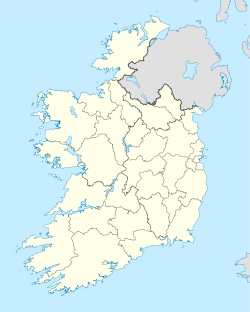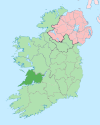- Doonbeg
-
Doonbeg
Dúnbeag— Town — Location in Ireland Coordinates: 52°44′N 9°31′W / 52.733°N 9.517°WCoordinates: 52°44′N 9°31′W / 52.733°N 9.517°W Country Ireland Province Munster County County Clare Time zone WET (UTC+0) - Summer (DST) IST (WEST) (UTC-1) Irish Grid Reference Doonbeg (Irish: Dúnbeag, meaning "Small Fort") is a village in West County Clare in Ireland. It is situated on the N67 between the towns of Kilkee and Miltown Malbay. The nearest large towns are Kilrush and Kilkee which are both approximately 7 miles away.
The central point of the village is an architecturally significant seven arched stone bridge which crosses the Doonbeg river and divides the village. This is famous as a lady called Mary Belfast used to live under one of the arches and the remains of her dwelling exist to this day. The crossing is overlooked by the remaining fortifications of Doonbeg castle.[citation needed]
The village is located in Killard parish and in the diocese of Killaloe. There is a modern Roman Catholic church located in the village built in the 1970s and noteworthy for the stain glass windows that are uniquely designed so that the various colours illuminate the altar throughout the day. There are also several pubs, Doonbeg National School, two shops, a post office and a village hall and tourist office.
Doonbeg is sometimes referred to as "The Long Village" due to the length of its main street. It is reputed to be one of Ireland's longest villages.[citation needed]
Contents
Sport
Gaelic football is popular in Doonbeg. The main playing area is the Shanahan McNamara Memorial grounds which are located outside the village. Doonbeg GAA is the second most successful gaelic football club in the history of Clare Senior Football Championship having won 18 county titles. Doonbeg's football team is known as "The Magpies" as a result of the black and white shirts which are traditionally worn. The famous Clare footballer, Gerry Killeen also played for the "Magpies".[citation needed]
The prestigious Greg Norman designed golf links Doonbeg Golf club is situated outside the village.
Doonbeg is home to one of Clares best surf beaches known locally as "Doughmore". The beach includes hazards such as strong rip currents and has been signposted as "dangerous for bathing" by Clare County Council. It is popular among local intermediate surfers as it picks up the smallest swells when none of the surrounding beaches will and due to its tranquility. The beaches tranquility is mainly due to the difficulty of access. The beach runs parallel to Doonbeg Golf course which must be crossed in order to get onto the beach.
History
A settlement has existed at the current river crossing since medieval times. The village name Dunbeag or small fort possibly refers to Doonbeg castle or an earlier fortification located at the river crossing . The castle was built in the 16th century, it has been historical associated with the MacMahon and O'Brien clans.[citation needed]
Geography
Doonbeg is surrounded by farmland the majority of which is used for dairy farming. There is also extensive bogland area near the village. The best areas to visit are in Tulliher and Derryard. The Doonbeg River flows through the village and enters the Atlantic Ocean at the nearby Doonbeg Bay where there is a fishing pier located beside the ruins of Doonmore Castle.
Walking South from Doonbeg along the coast towards Kilkee takes you along magnificent cliffs including the horseshoe cliff, its name deriving from the spectacular shape and double cave contained at the base.[citation needed]
Tourism
Traditional music and dancing are popular in the pubs of Doonbeg. Special events include the Willie Keane Memorial Weekend in October. In addition to this, there is also a jazz festival on Whit Weekend in June. The village is also host to the West Clare Drama Festival which was established in 1962.[citation needed]
In the outlying parish, popular scenic areas are the cliffs of Baltard and Killard and the popular White Strand beach which is located in the townland of Killard. Surfing has become popular in recent times along the northern coastline of the parish.
The White Strand beach in Killard attracts lots of visitors during the summer due to the availability of two beachs for safe swimming and the cleaniness of the water. Nearby there is a monument to Pat McDonald who was born in Millard and won an Olympic Gold Medal representing the US in Men's Shot Put. When he won his Olympic gold medal in 1920, he was aged 42, making him the oldest Olympic track & field champion ever.
There are picnic areas on the banks of the river near the bridge; it is also possible to fish in this area. Fishing is also possible around the coastal area of Doonbeg and shore fishing from the Blue Pool in Baltard is popular but dangerous in bad weather.[citation needed]
See also
External links
- Doonbeg Homepage
- County Clare Tourism
- Doonbeg Golf Course
- Further information on Pat McDonald
- Cree, Doonbeg & West Clare
Places in County Clare County town: Ennis Towns Villages Ardnacrusha · Aughinish · Ballynacally · Ballyvaughan · Barefield · Bodyke · Bridgetown · Broadford · Cahiracon · Carrigaholt · Clarecastle · Clonlara · Cloonanaha · Connolly · Cooraclare · Coore · Corofin · Cratloe · Cree · Cross · Crusheen · Doolin · Doonaha · Doonbeg · Ennistymon · Fanore · Feakle · Hurlers Cross · Inagh · Ivarstown · Kilbaha · Kildysart · Kilfenora · Kilkishen · Killaloe · Killimer · Kilmihil · Kilnamona · Knock · Labasheeda · Lahinch · Liscannor · Lisdoonvarna · Lisseycasey · Meelick · Milltown Malbay · Mountshannon · Mullagh · Murroogh · Newmarket-on-Fergus · O'Brien's Bridge · O'Callaghans Mills · Parteen · Quilty · Quin · Ruan · Scarriff · Sixmilebridge · Spancill Hill · Spanish Point · Tuamgraney · Tulla · WhitegateTownlands Ardsallis · Ballaghline · Burren · Coolmeen · Deer Island · Drumcliff · Inis Cathaig (or Scattery Island) · Ogonnelloe · TulligList of townlands in County Clare · Category:Mountains and hills of County Clare · Category:Rivers of County Clare · Category:Geography of County Clare Categories:- Towns and villages in County Clare
Wikimedia Foundation. 2010.


